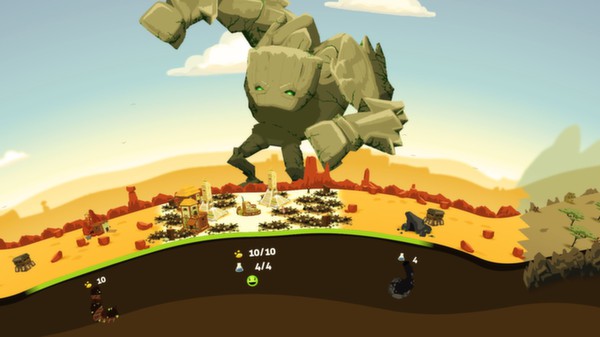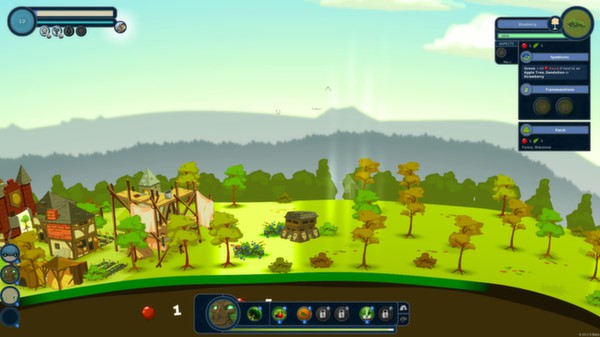Reus markets itself as a 2D god game. Indeed, at first glance that’s exactly what it looks like, as the player controls four planet-shaping giants on a mission to help humans survive and thrive on a once barren wasteland. However, after putting over a dozen hours into Reus, I’d describe it as more of a puzzle/resource management game, where you are trying to figure out the optimal placement of resources in a very limited space. In any case, Reus can be a hard game to accurately describe because of how unique it truly is.
Each game of Reus starts out the same: The planet is an uninhabitable wasteland and you must use your four giants to create an ecosystem that allows humanity to survive. Each giant has some sort of terraforming power that allows you to create mountains, forests, swamps, oceans, and deserts. Once you have biomes you must then place resources (minerals, plants, or animals) which in turn attract nomads that set up a village near these resources.
As villages grow, they’ll start projects. These projects usually require the use of a certain number of resources, like food, tech, and/or wealth. These are generated by the resources that are within a village’s borders, which gradually expand as the village grows. Once a project is complete, it will add bonuses to the village and push it towards a certain specialization, like giving a village more wealth for each mineral within their borders or giving more food for each plant. The types of projects a village will start largely depend on the biome they are in. Deserts usually start wealth-based projects, swamps start tech-based ones, and forests food-based ones.
Besides allowing a village to grow, projects also give you ambassadors. Your giants can pick up these ambassadors, unlocking new abilities. The ability that an ambassador unlocks depends on what biome they are from and what giant is carrying them. Giving a giant more ambassadors from the same biome is useful because the extra ambassadors upgrade the power associated with ambassadors from that specific biome. This creates a situation where you have to carefully consider what ambassadors to give to what giants. You’ll need to consider what abilities you’ll need in order to advance the villages the way you want them to go. You’ll also need to think about if you would rather spread out ambassadors from specific biomes to gain a wider range of abilities, or give all the ambassadors of a specific biome to one giant so you can make his abilities more powerful.
While it can be tempting to just throw resources at a village to make them grow as fast as possible, there is a greed mechanic that makes this more difficult. If a village grows too quickly, they may become greedy and demand more from you or attack other villages. The growth of greed can be managed by awe and danger, which are generated by certain resources. Placing predatory animals is an easy way of generating danger, thus slowing a village’s expansion and keeping their greed at bay, but if there is too much danger it can cause the village to struggle to survive. Like most mechanics in this game, it can be a very fine balancing act that requires a lot of experimentation.
The way resources interact and how you can transform and modify them is a lot more complex than I originally thought it would be. Each giant has abilities that generate a generic resource like precious minerals or fruit plants, with the actual type of resource generated depending on the biome. Using the Swamp Giant’s ability to create exotic animals will create a poison dart frog in swamps, but desert tortoises in deserts. As you can imagine, this already means that the number of resources can get a bit daunting, but things get further complex with the use of Aspects.
Aspects serve two purposes. Firstly, they can increase resources generated, or modify them in different ways. Secondly, you can transform resources if there are certain Aspects attached to them. For example, adding a Leaf Aspect to blueberries allows you to make strawberries. In addition to Aspects, there are also Symbioses that give bonuses to resources that are next to certain other resources. Predatory animals typically generate more wealth or food if they are near smaller prey animals, certain plants generate more food if they are near mineral-rich ground, and so on.
This level of complexity in how specific resources interact and what Aspects are needed to make each resource can be really overwhelming later in the game. The game would greatly benefit from an in-game tech tree of some sort. As it stands, all you can do is pull up a wiki, which makes it more difficult to reference things while actually playing. As you gain access to more resources, the massive number of them and how they interact can get fiddly too, as you try to figure out the most optimal arrangement of resources for a village’s specialization. It doesn’t help that villages often start on projects that make no sense considering previous projects, like a village that focused heavily on plants suddenly starting a project that requires a lot of animals. The limited space of the world makes matters even worse. I understand that this game is mainly about managing resources in a limited space, but I’d like to see larger worlds in future updates.
Despite my complaints so far, I actually really enjoy Reus. The graphics style and music are incredibly charming, and despite the occasional awkwardness of the resource management, the game can be almost zen-like. For the most part it is a relatively stress-free, relaxing game. It’s satisfying to see your villages gradually grow and become bustling cities. The giants and their animations look great in action, and their idle animations add a lot to the game’s charm. They’ll occasionally lean down and just watch the villagers as they go about their daily lives, as proud parents watching their children play.
While the resources and the way they interact can become very complex later on, the game’s learning curve is actually brilliant. Most of the resources are locked at the start; you “level up” by playing and completing developments. Developments are a bit like achievements, but they serve an actual gameplay purpose. As you complete developments and level up, you’ll unlock more resources and tougher developments become possible. The actual game modes themselves are designed to slowly ease you in. After the tutorial, you start with 30 minute games, where many of the more complex resource interactions won’t really come into play. Then you’ll graduate to hour-long games, and eventually two hour games, where you need to carefully consider resource placement to make the best use of Symbioses, which Aspects you need, etc. Greed, and how villages may lose their faith and attack your giants, also doesn’t become a major mechanic until the two hour games. In addition to these primary modes, there is also a free play sandbox mode where you can play as long as you like, but you won’t make progress towards new resources and developments.
Reus is a really unique title that deserves your attention. I don’t think you should really go into Reus expecting a true god game along the lines of Populous, but rather a puzzle game with the façade of a god game. I’ve heard some people say that Reus lacks a real focus or objective due to the way the game is designed, but I’m not so sure I agree. It is a very charming and beautiful puzzle game that rewards you for experimenting and trying to figure out the optimal way of creating thriving villages in a limited space. If you’re looking for a relatively slower-paced, charming, and relaxing title, then Reus is definitely worth a look at only $10. You can find it on Steam and GOG.com.







